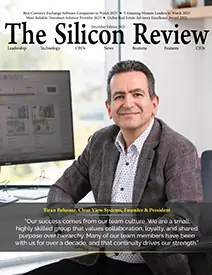>>
Technology>>
Science and technology>>
Laser Engraving 101: A Beginne...Laser Engraving 101: A Beginner's Guide to the Technology
The Silicon Review
15 April, 2025
Laser engraving has become a popular method for customizing and marking various materials with intricate designs, text, or logos. Its appeal lies in the precision, speed, and versatility it offers across different industries. This guide provides a thorough overview of laser engraving technology, explaining its operation, applications, and various machine types.
What is Laser Engraving?
Laser engraving is a process that uses focused laser beams to etch or mark a surface. A laser engraving machine works by vaporizing the material at the point of contact, creating a permanent mark or engraving. The technology can be used on a wide variety of materials, including wood, metal, plastic, and glass. It is important to note that laser engraving, laser etching, and laser marking are distinct processes, though they are often used interchangeably. The primary difference lies in the depth and permanence of the mark, with engraving typically creating deeper and more permanent impressions.
History of Laser Engraving
Laser engraving technology originated in the 1960s, following the development of the laser itself. The first laser systems were used in scientific and medical applications, but by the 1970s, the technology began to be adapted for industrial uses. Over the years, advances in laser technology, particularly with the advent of computer numerical control (CNC) systems, allowed for greater precision and automation. As the technology matured, laser engraving found its place in a variety of industries, from manufacturing to personalization, becoming a versatile tool for a range of applications.
How Does Laser Engraving Work?
Laser engraving involves several key components working together. The process begins with the creation of a design, usually on a computer using specialized software. This design is then sent to the laser engraving machine, where it is converted into a set of instructions for the laser system. The laser beam is focused on the material’s surface, and the heat from the laser vaporizes the material in the targeted area, creating an engraving.
Key factors that affect the quality of engraving include the laser's power, speed, and resolution. The laser’s power controls how deep the engraving goes, while the speed determines how quickly the laser moves across the surface. The resolution is measured in DPI (dots per inch) and affects the level of detail in the engraving.
Types of Laser Engraving Machines
There are several types of laser engraving machines, each suited to different materials and applications:
- CO2 Lasers: These are the most common type of laser engravers. CO2 lasers use a gas mixture to generate the laser beam and are effective for non-metallic materials such as wood, acrylic, glass, and leather.
- Fiber Lasers: These lasers use optical fibers doped with rare-earth elements to generate the laser. Fiber lasers are highly effective for engraving metals, making them a popular choice for industrial applications.
- Diode Lasers: Smaller and more affordable, diode lasers are often used for lighter engraving tasks, particularly on wood, plastic, and leather. They are commonly found in hobbyist and smaller-scale systems.
Each type of laser has its strengths and is chosen based on the specific material and project requirements.
Applications of Laser Engraving
Laser engraving has a wide range of applications across various industries:
- Personalization: Items such as gifts, jewelry, and trophies can be engraved with unique designs, names, or messages, adding a personal touch.
- Industrial Applications: Laser engraving is often used in the manufacturing sector for marking parts with serial numbers, logos, and other identifying features.
- Art and Design: Artists use laser engraving to create intricate designs on materials such as wood, stone, and metal. The precision of the laser allows for detailed artwork that would be difficult to achieve with traditional methods.
- Signage and Branding: Laser engraving is commonly used to create durable and highly detailed signs and brand logos on products, offering a clean, professional finish.
- Manufacturing: In the automotive and aerospace industries, laser engraving helps with part identification, traceability, and the marking of components with important technical information.
Advantages of Laser Engraving
The popularity of laser engraving can be attributed to several advantages it offers:
- Precision and Detail: Laser engraving is capable of producing incredibly fine details and intricate designs, making it ideal for high-precision applications.
- Versatility in Materials: Laser engravers can work with a wide variety of materials, making them useful for many different industries and applications.
- Speed and Efficiency: Once set up, laser engraving is a fast process, allowing for quick turnaround times, especially in bulk manufacturing.
- Minimal Waste: Because laser engraving is a non-contact process, there is little material waste, unlike methods such as milling or traditional printing.
- Durability: Engravings made by lasers are permanent, making them resistant to fading, wear, and tear over time.
Limitations of Laser Engraving
Despite its many advantages, laser engraving has some limitations:
- Material Restrictions: Not all materials can be easily engraved with a laser. Highly reflective materials, such as certain metals, can cause issues, while some materials may not respond well to the laser’s heat.
- High Initial Cost: Industrial-grade laser engraving machines can be expensive, making them a significant investment for businesses. However, prices have become more affordable for smaller systems in recent years.
- Size Restrictions: While laser engravers are suitable for small to medium-sized projects, larger items may require more specialized equipment or be impractical for engraving.
- Complexity: Advanced laser engraving systems require skilled operators to set up and maintain, which can be a barrier for those new to the technology.
Choosing the Right Laser Engraver
Selecting the appropriate laser engraver depends on several factors:
- Material Type: Different lasers are suited to different materials, so it is essential to choose one that matches the specific materials being engraved.
- Project Size: For larger items, a machine with a larger work area is necessary. Smaller systems are better suited for intricate designs on smaller items.
- Budget: The cost of the machine will vary based on its features, material compatibility, and brand. It's important to balance the price with the machine's capabilities.
- Ease of Use: Some laser engraving machines come with user-friendly interfaces and software, while others may require more technical knowledge.
For those seeking a reliable laser engraver, OMTech laser machines are a great choice. They offer models like the Turbo Series, suitable for various materials and project sizes, and the Pro 3655, which is ideal for high-volume production with its large work area and advanced features.
Common Misconceptions about Laser Engraving
Several misconceptions surround the world of laser engraving:
- Laser Engraving is Expensive: While industrial-grade machines can be costly, more affordable systems are available for smaller projects or hobbyists.
- Laser Engraving is Only for Large Companies: Laser engraving is accessible to small businesses and even hobbyists, especially with the availability of smaller, more affordable machines.
- Laser Engraving is Only for Metal: While metal engraving is a popular application, laser engraving is effective on a wide variety of materials, including wood, glass, acrylic, and more.
Safety Considerations
Safety is crucial when operating a laser engraving machine. Operators should always wear appropriate protective eyewear to safeguard against laser exposure. Proper ventilation is also necessary, as certain materials can release harmful fumes during engraving. Additionally, understanding the specific laser class and following safety guidelines is essential for safe operation.
Future of Laser Engraving Technology
Laser engraving technology continues to evolve. Innovations in automation, AI, and machine learning are making laser engravers smarter and more efficient. There is also growing interest in sustainable materials and processes, with the laser engraving industry seeking to reduce its environmental impact. As technology progresses, laser engraving is expected to expand into new industries and applications.
Conclusion
Laser engraving offers unmatched precision and versatility, making it an invaluable tool for various industries, from personalization to manufacturing. While it has some limitations, its numerous advantages make it a preferred method for engraving a wide range of materials. With continued advancements in technology, laser engraving is poised to remain a key player in the world of customization and industrial manufacturing.
_2025-12-15_12-44-58.webp)


_2025-11-17_06-38-14.webp)

 (1)_2025-10-21_13-35-14.webp)
